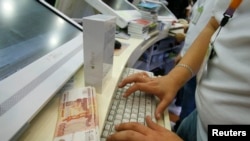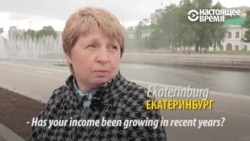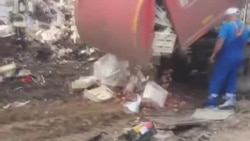In his interview with Prime Minister Dmitry Medvedev, TV presenter Sergey Brilev mainly listened to the leader of the Russian Federation’s executive branch, without challenging Mevedev’s rosy narrative about Russia’s stagnant economy.
Medvedev refused to rate his own six-year performance, but complained about the harmful sanctions regime and low oil prices. Still, he said it was “good” that Russia’s aggregated growth in gross domestic product (GDP) in 2012 – 2018 was 5 percent.
Russia emerged from recession last year but the growth of the economy has continued to lag, falling well below 3 percent, which fits into the accepted definition of "stagnation." So we rate Medvedev's characterization to be false.
With prime minister's approval rating at 40 percent, the lowest in a decade, he talks of leading the Russian people to prosperity. The record shows stagnation and reduced income.
Medvedev, who was prime minister from 2005 - 2008, stepped back into that post in 2012 after serving four years as president. The World Bank reports Russia’s GDP grew 3.2 percent in 2012, and the average Russian income that year was 27,000 rubles (a little less than $1,000) a month.
The GDP growth rate fell to 1.7 percent in 2013, and in 2014, the year Russia annexed Crimea and held the Winter Olympics, the GDP suffered another drop, hitting 0.7 percent. It bottomed out at -2.8 percent in 2015, a period of recession.
Russia’s GDP began crawling out of the ditch in 2016, registering -0.2 percent growth, and rose back above zero in 2017, with a 1.5 percent growth rate.
In 2016, the average Russian monthly income was about 35,000 rubles, but this was worth only $450 because the Russian ruble had lost half of its purchasing power.
How far does $450 a month go in Russia?
Just to put things in perspective, an iPhone X currently costs some 80,000 rubles (or $1,300) which is three time the monthly Russian national average income.
The 2012 version of the iPhone could be purchased in Russia for 30,000 rubles ($1,000), equal to a Russian monthly income. (attribution)
Many Russians earn far less than the average income, with incomes as low as 15,000 rubles ($230) or even 12,000 ($180) a month.
During the six years since 2012 that Russia has seen its GDP grown an average of just 0.8 percent yearly, the average global GDP has grown 2.5 percent annually, with 2.8 percent increase registered in 2015.
Over the last few years, the Russian economy has been stagnant, and the latest Western sanctions against Moscow will likely prevent much improvement.
In 2016, Russia performed economically on par with Greece and the Federal States of Micronesia, and slightly better than Burundi, Belize and Angola.
In 2016, Russia's Baltic neighbors Latvia and Estonia grew at 3.2 percent and 2 percent, respectively, while the average yearly income in was $14,000 in Latvia, and $18,000 in Estonia, almost twice as much as in Russia, which had an average yearly income of $8,700.
In 2017, under Medvedev’s stewardship of the economy, Russia destroyed more than 300 tons of “embargoed foods” including fresh vegetables, fruit, cheeses, and other produce as a counter-sanctions measure imposed on countries that curbed exports into Russia.
The Russian-language website of Germany’s Deutsche Welle did the math: the amount of destroyed produce could have fed guests at 100,000 wedding receptions or the entire population of the Russian city of Nizny Tagil for a month.










